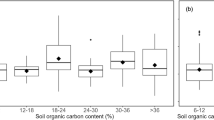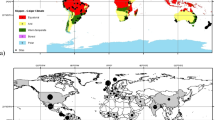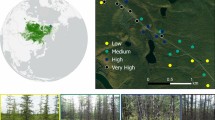Abstract
Because dry-deposition inputs are difficult to measure, they are often ignored in biogeochemical studies. In this study three separate methods were used to estimate dry deposition of nitrate to a deciduous forest (Walker Branch Watershed) in eastern Tennessee. The range of estimates of dry-deposition flux was from 1.8 to 9.1 kg NO3 --N ha-1 yr-1 Using a hybrid approach that combines some aspects of all three methods, a best estimate of 4.8 kg NO3 --N ha-1 yr-1 was derived. About 75% of this flux is attributable to deposition of HNO3, vapor with large particles contributing most of the remainder; the contribution from small particles is negligible. The range of estimates obtained from the three techniques suggest that dry-deposition measurements should be interpreted with caution.
Our best estimate indicates that dry deposition of NO3 - is the largest single form of inorganic nitrogen (N) deposition to this forest, contributing almost half of the 10.1 kg N ha-1 total annual input. All of the enhancement of NO3 - deposition in stemflow and throughfall relative to incident precipitation can be explained by washoff of dry-deposited NO3 -, and some canopy uptake of dry-deposited NO3 - is suggested. This uptake occurs primarily during the growing season and contributes from 0.2 to 7.5 kg N ha-1 yr-1 to the N requirements of the ecosystem, with a best estimate of 3.2. Despite the uncertainties, the magnitude of the potential input fluxes to forested ecosystems necessitates consideration of nitrate dry deposition in ecosystem nitrogen cycling studies.
Similar content being viewed by others
References
Appel, B.R., Y. Tokiwa, and M. Haik. 1981. Sampling of nitrates in ambient air. Atmospheric Environment 15: 283–289.
Brimblecombe, P., and D.H. Stedman. 1982. Historical evidence for a dramatic increase in the nitrate component of acid rain. Nature 398: 460–462.
Carlisle, A., E.J. Brown and E.J. White. 1967. The organic matter and nutrient elements in the precipitation beneath a sessile oak canopy. Journal of Ecology 54: 87–98.
Dasch, J.M. 1983. A comparison of surrogate surfaces for dry deposition collection. IN H.R. Pruppacher, R.G. Semonin, and W.G.N. Slinn (eds.), Precipitation scavenging, dry deposition, and resuspension, pp. 883–902, Elsevier, New York.
Davidson, C.I., W.D. Goold, and G.B. Wiersma. 1983. Dry deposition of trace elements in Olympic National Park IN H.R. Pruppacher, R.G. Semonin, and W.G.N. Slinn (eds.), Precipitation scavenging, dry deposition, and resuspension, pp. 871–882, Elsevier, New York.
Environmental Protection Agency (EPA). 1984. The acidic deposition phenomenon and its effects. Vol I: Atmospheric sciences. EPA-60018-83-016A, U.S. EPA, Washington, D.C.
Fowler, D. 1980. Removal of sulphur and nitrogen compounds from the atmosphere in rain and by dry deposition IN D. Drablos and A. Tolan (eds.), Ecological impact of acid precipitation, pp 23–32, SNSF Project, Oslo, Norway.
Friedland, A.J., R.A. Gregory, L. Kärenlampi, and P.H. Johnson. 1984. Winter damage to foliage as a factor in red spruce decline. Canadian Journal of Forest Research 14: 963–965.
Galloway, J.N., and G.E. Likens. 1981. Acid precipitation: The importance of nitric acid. Atmospheric Environment 15: 1081–1085.
Grennfelt, P., C. Bergston, and L. Skarby. 1983. Dry deposition of nitrogen dioxide to Scots pine needles. IN H.R. Pruppacher, R.G. Semonin, and W.G.N. Slinn (eds.), Precipitation scavenging, dry deposition, and resuspension, pp. 753–762, Elsevier, New York.
Hicks, B.B. 1983. Dry deposition. IN The acidic deposition phenomenon and its effects. Vol I: Atmospheric sciences, Chapter 8. EPA-60018-83-016A, U.S. Environmental Protection Agency, Washington, D.C.
Hicks, B.B., M.L. Wesely, and J.L. Durham. 1980. Critique of methods to measure dry deposition. EPA-600/9-80-050, U.S. Environmental Protection Agency, Washington, D.C.
Hicks, B.B., and J.A. Garland. 1983. Overview and suggestions for further research on dry deposition. IN H.R. Pruppacher, R.G. Semonin and W.G.N. Slinn (eds.), Precipitation scavenging, dry deposition, and resuspension, pp. 1429–1433, Elsevier, New York.
Horvath, L. 1983. Trend of nitrate and ammonium content of precipitation water in Hungray for the last 80 years. Tellus 35B: 307–308.
Huebert, B.J. 1983. Measurements of the dry deposition flux of nitric acid vapor to grasslands and forests. IN H.R. Pruppacher, R.G. Semonin, and W.G.N. Slinn (eds.), Precipitation scavenging, dry deposition, and resuspension, pp. 785–794, Elsevier, New York.
Huebert, B.J., and C.H. Robert. 1985. The dry deposition of nitric acid to grass. Journal of Geophysical Research 90 (D1): 2085–2091.
Hutchinson, B.A., D.R. Matt, R.T. McMillen, L.J. Gross, S.J. Tajchman, and J.M. Norman. The architecture of an East Tennessee deciduous forest canopy. Journal of Ecology (in press).
Kelly, J.M., L.L. Taylor, and P.A. Mays. Evaluation of the role of atmospheric nitrogen deposition in the nitrogen input/output relationships of three forested watersheds. Final Report for Project RP–1727. Electric Power Research Institute, Palo Alto, California (in press).
Lang, G.E., W.A. Reiners, and R.K. Heier. 1976. Potential alteration of precipitation chemistry by epiphytic lichens. Oecologia (Berl.) 25: 229–241.
Lemee, G. 1974. Recherches sur les ecosystemes des reserves biologiques de la foret de Fontainebleau IV. Entrees d'elements mineraux par les precipitations et transfert au sol par le pluviolesivage. Oecologia Plantarum 9: 187–200.
Likens, G.E., F.H. Bormann, R.S. Pierce, J.S. Eaton, and N.M. Johnson. 1977. Biogeochemistry of a forested ecosystem. Springer-Verlag, New York.
Lindberg, S.E., and G.M. Lovett. 1985. Field measurements of dry deposition rates of particles to inert and foliar surfaces in a forest. Environmental Science and Technology 19: 228–244.
Lindberg, S.E., G.M. Lovett, and J.M. Coe. 1984. Acid deposition/forest canopy interactions. Final Report for Project RP-1907-1. Electric Power Research Institute, Palo Alto, California.
Lovett, G.M. 1983. Atmospheric deposition to forests. IN C.S. Cronan (ed.), Forest responses to acidic deposition. pp. 7–18. Land and Water Resources Center, University of Maine, Orono, Maine.
Lovett, G.M., and S.E. Lindberg. 1984. Dry deposition and canopy exchange in a mixed oak forest as determined by analysis of throughfall. Journal of Applied Ecology 21: 1013–1028.
McColl, J.G., and P.S. Bush. 1978. Precipitation and throughfall chemistry in the San Francisco Bay area. Journal of Environmental Quality 7: 352–357.
Olson, R.K., W.A. Reiners, and C.S. Cronan. 1981. The chemistry and flux of throughfall and stemflow in subalpine balsam fir forests. Holarctic Ecology 4: 291–300.
Parker, G.G. Throughfall and stemflow in the forest nutrient cycle. Advances in Ecological Research 13: 57–133.
Sickles, J.E., II, W.D. Bach, and L.L. Spiller. 1983. Comparison of several techniques for determining dry deposition, flux. IN H.R. Pruppacher, R.G. Semonin, and W.G.N. Slinn (eds.), Precipitation scavenging, dry deposition, and resuspension, p. 979–990.
Spicer, C.W., and P.M. Schumacher. 1979. Particulate nitrate: laboratory and field studies of major sampling interferences. Atmospheric Environment 13: 543–552.
Tjepkema, J.D., R.J. Cartica and H.F. Hemond. 1981. Atmospheric concentration of ammonia in Massachusetts and deposition on vegetation. Nature 294: 445–446.
Verry, E.S., and D.R. Timmons. 1977. Precipitation nutrients in the open and under two forests in Minnesota. Canadian Journal of Forest Research 7: 112–119.
Wedding, J.B., A.B. McFarland, and J. Cermak. 1977. Large-particle collection characteristics of ambient aerosol samplers. Environmental Science and Technology 11: 387–390.
Wesely, M.L., D.R. Cook, and R.L. Hart. 1983. Fluxes of gases and particles above a deciduous forest in winter-time. Boundary-layer Meteorology 27: 237–255.
Wolff, G.T. 1984. On the nature of nitrate in coarse continental aerosols. Atmospheric Environment 18: 877–981.
Author information
Authors and Affiliations
Rights and permissions
About this article
Cite this article
Lovett, G.M., Lindberg, S.E. Dry deposition of nitrate to a deciduous forest. Biogeochemistry 2, 137–148 (1986). https://doi.org/10.1007/BF02180191
Issue Date:
DOI: https://doi.org/10.1007/BF02180191




